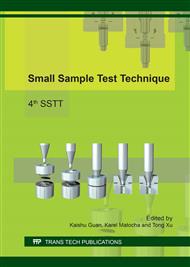[1]
X.T. Tang, M.Y. He. The micro-tensile tests and size effect research of the micro-copper fiber, Huazhong University of Science and Technology, (2012).
Google Scholar
[2]
K.S. Kim, J.Y. Song, E.K. Chung. Et. al., Relationship between mechanical properties and microstructure of ultra-fine gold bonding wires, J. Mechanics of Materials. 38(2006) 119-227.
DOI: 10.1016/j.mechmat.2005.05.015
Google Scholar
[3]
Czerny B, Lederer M, Nagl B, et al., Thermo-mechanical analysis of bonding wires in IGBT modules under operating conditions, J. Microelectronics Reliability. 52(2012) 2353-2357.
DOI: 10.1016/j.microrel.2012.06.081
Google Scholar
[4]
Y.T. Tian, J. Cao, et al., Research and Application of Electronic Packaging Cu bonding wires, J. Casting technique. 27(2006) 971-974.
Google Scholar
[5]
Y.T. Tian, J. Cao, et. al, Breaking study of single crystal copper bonding wire in the process of preparation, J. Journal of Mechanical Engineering. 46(2010) 84-89.
Google Scholar
[6]
Christopher L, Muhlstein, Stuart B Brown, Robert O Ritchie, High-Cycle Fatigue of Single-Crystal Silicon Thin Films, J. Microelectromechanical Systems Journal of, 10(2001) 593-600.
DOI: 10.1109/84.967383
Google Scholar
[7]
C.L. Muhlstein, S.B. Brown, R.O. Ritchie, High-cycle fatigue and durability of polycrystalline silicon thin films in ambient air, J. Sensors and Actuators A Physical, 94(2011) 177-188.
DOI: 10.1016/s0924-4247(01)00709-9
Google Scholar
[8]
K. Komai, K. Minoshima, H Tawara, S. Inoue, K. Sunako. Development of Mechanical testing machine for microelements and fracture strength evaluation of single-crystalline silicon microelements, J. Nihon Kikai Gakkai Ronbunshu A, Hen/transactions of the Japan Society of Mechanical Engineers Part A, 60(1994).
DOI: 10.1299/kikaia.60.52
Google Scholar
[9]
K. Hergen, A. Robert, B. Josef, Fracture Strength and Fatigue of Polysilicon Determined by a Novel Thermal Actuator [MEMS], J. IEEE Transactions on Electron Devices, 47(2000) 1522-1528.
DOI: 10.1109/16.848302
Google Scholar
[10]
T. Tsuchiya, Tensile testing of silicon thin films, J. Fatigue & Fracture of Engineering Materials & Structures, 28(2005) 665-674.
DOI: 10.1111/j.1460-2695.2005.00910.x
Google Scholar
[11]
J.A. Connally, S.B. Brown, Slow Crack Growth in Single-Crystal Silicon, J. Science, 256. 5063(1992) 1537-1539.
DOI: 10.1126/science.256.5063.1537
Google Scholar
[12]
M.J. Qi, Z.W. Liu, X.J. Yan, A low cycle fatigue test device for micro-cantilevers based on self-excited vibration principle, J. Review of Scientific Instruments 85(2014), 105005-105005-5.
DOI: 10.1063/1.4898668
Google Scholar
[13]
Z.W. Liu, Theoretical and Experimental Research on micro - structural fatigue, D. BeiJing: Beihang University, (2013).
Google Scholar
[14]
L.L. Chen, J.Y. Tang, J. Song, The high-cycle fatigue properties of double-clamped polysilicon beam, J. Sensors and Transducers Technology, 22(2009) 208-212.
Google Scholar
[15]
N.L. Phung, V. Favier, N. Ranc, F. Valès, H. Mughrab, Very high cycle fatigue of copper: Evolution, morphology and locations of surface slip markings, J. International Journal of Fatigue 63(2014) 68–77.
DOI: 10.1016/j.ijfatigue.2014.01.007
Google Scholar
[16]
S. Stanzl-Tschegg, H. Mughrabi, B. Schönbauer, Life-time and cyclic slip of copper in the VHCF regime, J. International Journal of Fatigue. 29(2007) 2050–(2059).
DOI: 10.1016/j.ijfatigue.2007.03.010
Google Scholar
[17]
B. Yang, C. Motz, W, Grosinger, G. Dehm, Stress-controlled fatigue behaviour of micro-sized polycrystalline copper wires, J. Materials Science & Engineering A, 515(2009) 71–78.
DOI: 10.1016/j.msea.2009.02.037
Google Scholar
[18]
M. Goto, N. Teshima, et al., High-cycle fatigue strength and small-crack growth behavior of ultrafine-grained copper with post-ECAP annealing, J. Engineering Fracture Mechanics 110(2013) 218–232.
DOI: 10.1016/j.engfracmech.2013.07.018
Google Scholar
[19]
T.C. Hu, Y.T. Wang, et al., Cyclic creep and fatigue testing of nanocrystalline copper thin films, J. Surface & Coatings Technology 215(2013) 393–399.
DOI: 10.1016/j.surfcoat.2012.08.089
Google Scholar


